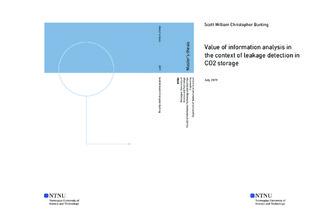| dc.contributor.advisor | Eidsvik, Jo | |
| dc.contributor.author | Scott William Christopher Bunting | |
| dc.date.accessioned | 2019-10-26T14:00:25Z | |
| dc.date.available | 2019-10-26T14:00:25Z | |
| dc.date.issued | 2019 | |
| dc.identifier.uri | http://hdl.handle.net/11250/2624594 | |
| dc.description.abstract | Karbonfangst og -lagring er en lovende strategi for å redusere utslipp av CO2 til atmosfæren og i disse tider forberedes et fullskala prosjekt i Norge. CO2 vil bli injesert i dype geologiske formasjoner, og blant stedene som studeres for lagring er Smeaheia som ligger i Nordsjøen. En av hovedrisikoene forbundet med CO2-lagring er lekkasje, og det er viktig å lage monitoreringsprogram som addresserer dette og andre risikoer. Monitorering er kostbart, så det er viktig å lage slike programmer på en smart måte som optimerer forholdet mellom verdi og kostnad. I et slikt arbeid bør en estimere verdien til et monitoreringsprogram. Dette kan gjøres ved å definere en beslutningssituasjon og så se på økningen i situasjonens verdi dersom en samler data før en tar beslutningen. Denne studien handler om å estimere verdien av informasjon for seismiske undersøkelser i forbindelse med CO2-lagring. Et rammeverk utvikles for å finne ut ved hvilket tidspunkt en seismisk undersøkelse har størst verdi i forbindelse med å detektere CO2-lekkasje. Beslutningen som studeres er om en skal fortsette eller avbryte lagringen av CO2. I rammeverket brukes Monte Carlo simulering sammen med statistiske regresjonsteknikker for å beregne verdien av informasjon. Rammeverket illustreres gjennom et konstruert eksempelstudie knyttet til Smeaheia. Reservoarsimuleringer gjøres ved bruk av Matlab Reservoir Simulation Toolbox, og fra simulerte CO2-metninger konstrueres seismiske data. Deretter brukes regresjonsmodeller for å beregne verdier gitt data, som så brukes for å estimere verdien av informasjon. To regresjonteknikker testes i studien, k-nærmeste naboer (KNN) og konvolusjonelle nevrale nettverk (CNN). Beregnede verdier av informasjon var konsistent lavere ved å bruke KNN sammenlignet med CNN. Det er mulig at estimatene fra en eller begge metodene ikke er forventningsrette. Videre, ved å gjøre bootstrapping, så kunne vi se at KNN produserer stabile estimater, mens CNN produserer estimater med høy varians. Den høye variansen kan skyldes den begrensede størrelsen på datasettet. I eksempelstudien fikk vi ikke til å oppgi et eksakt tidspunkt for når verdien av en seismisk undersøkelse vil være størst, men vi fikk til å oppgi et redusert tidsintervall hvor det er sannsynlig at den største verdien ligger. | |
| dc.description.abstract | Carbon capture and storage (CCS) is seen as a promising strategy to reduce emissions of CO2 into the atmosphere. Currently preparations are being done in Norway for a full-scale CCS project. CO2 will be stored in deep geological formations, and one of the locations being studied for such storage is Smeaheia, located in the North Sea. One of the major risks related to such a storage project is leakage of CO2, and it is important to design monitoring programs addressing this and other risks. Monitoring is expensive, so it is important to design monitoring programs in a smart way, in order to optimize the relationship between value and cost. One possible way to asses the value of a monitoring program is value of information analysis. In such an analysis one defines a decision problem and measures the value of information (VOI) as the additional value obtained by acquiring information before making the decision. This study concerns value of information analysis of seismic data in the context of CO2 storage decisions. In particular we develop a framework to assess when in time a seismic survey has most value for leakage detection. The decision considered is whether or not to continue the injection of CO2. In the framework, the simulation-regression approach is used to estimate the VOI at different times. This approach uses Monte Carlo simulation and statistical regression techniques to estimate the VOI. The framework is illustrated through a constructed case study using Smeaheia. Reservoir simulations are done using the Matlab Reservoir Simulation Toolbox (MRST). From simulated saturations of CO2, we generate seismic data. We then regress values on the seismic data, to estimate the VOI. Two regression techniques are tested - k-nearest neighbors regression with principal components of the seismic data and convolutional neural networks. VOI estimates obtained using the k-nearest neighbors regressions were consistently lower than the estimates obtained using the convolutional neural networks. It is possible that one or both of the methods make biased estimates of the VOI. Through bootstrapping, we saw that the k-nearest neighbors approach produced stable VOI estimates, while the convolutional neural networks produced estimates with high variability. The high variability might be due to the limiting size of the data set. In the case study, we were not able to say exactly at which time a seismic survey would have the highest value. However, we were able to give a reduced interval of time in which the VOI would most probably obtain its highest value. | |
| dc.language | eng | |
| dc.publisher | NTNU | |
| dc.title | Value of information analysis in the context of leakage detection in CO2 storage | |
| dc.type | Master thesis | |
